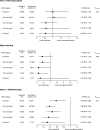Efficacy, Safety, and Exposure of Apixaban in Patients with High Body Weight or Obesity and Venous Thromboembolism: Insights from AMPLIFY
- PMID: 33890242
- PMCID: PMC8189985
- DOI: 10.1007/s12325-021-01716-8
Efficacy, Safety, and Exposure of Apixaban in Patients with High Body Weight or Obesity and Venous Thromboembolism: Insights from AMPLIFY
Erratum in
-
Correction to: Efficacy, Safety, and Exposure of Apixaban in Patients with High Body Weight or Obesity and Venous Thromboembolism: Insights from AMPLIFY.Adv Ther. 2021 Aug;38(8):4596-4597. doi: 10.1007/s12325-021-01822-7. Adv Ther. 2021. PMID: 34240312 Free PMC article. No abstract available.
Abstract
Introduction: As a result of limited clinical data, guidelines do not recommend the use of non-vitamin K antagonist oral anticoagulants in patients who weigh > 120 kg or have a body mass index (BMI) > 40 kg/m2.
Methods: This post hoc analysis of the AMPLIFY trial evaluated the efficacy (venous thromboembolism [VTE]/VTE-related death), safety (major and composite of major and clinically relevant non-major [CRNM] bleeding), and exposure of apixaban compared with enoxaparin followed by warfarin for the treatment of VTE by body weight (≤ 60, > 60 to < 100, ≥ 100 to < 120, ≥ 120 kg) and BMI (≤ 25, > 25 to 30, > 30 to 35, > 35 to 40, > 40 kg/m2).
Results: Among the AMPLIFY safety population, 5384 and 5359 patients had recorded body weight (range 28.9 to 222.0 kg; ≥ 120 kg, n = 290) and BMI (range 12.5-71.8 kg/m2; > 40 kg/m2, n = 263), respectively. The rates of recurrent VTE/VTE-related death for apixaban versus enoxaparin/warfarin were similar across body weight subgroups: relative risks (RR; 95% confidence intervals [CI]) were 0.63 (0.23, 1.72), 0.99 (0.65, 1.50), 0.77 (0.34, 1.72), and 0.20 (0.02, 1.72) for the ≤ 60, > 60 to < 100, ≥ 100 to < 120, and ≥ 120 kg groups, respectively (Pinteraction = 0.44). The rates of major bleeding were lower with apixaban versus enoxaparin/warfarin; RRs (95% CI) were 0.15 (0.02, 1.15), 0.41 (0.21, 0.77), not estimable, and 0.34 (0.04, 3.22), respectively (Pinteraction = not estimable). The rates of major/CRNM bleeding were significantly lower for apixaban versus enoxaparin/warfarin; RRs (95% CI) were 0.46 (0.24, 0.89), 0.49 (0.38, 0.63), 0.30 (0.16, 0.58), and 0.28 (0.12, 0.66), respectively (Pinteraction = 0.36). Similar trends were seen in the BMI subgroups. There was a modest, not clinically meaningful, decrease (< 30%) in the median predicted exposure with increasing body weight (n = 281).
Conclusions: The findings of this post hoc analysis support the use of apixaban in patients with body weight ≥ 120 kg or BMI > 40 kg/m2.
Trial registration number: NCT00643201.
Keywords: Apixaban; Body mass index; Body weight; Enoxaparin; Venous thromboembolism; Warfarin.
Figures



References
-
- World Health Organization. WHO obesity and overweight fact sheet. 2020. https://www.who.int/news-room/fact-sheets/detail/obesity-and-overweight. Accessed 31 August 2020.
Publication types
MeSH terms
Substances
Associated data
LinkOut - more resources
Full Text Sources
Medical
Research Materials

